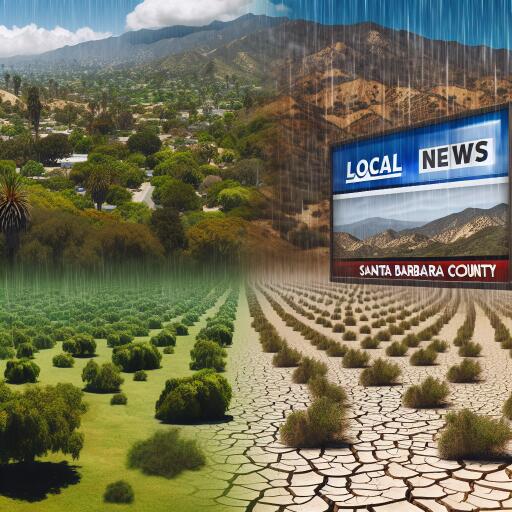
After 2 Wet Years, Drought Conditions Resurface in Santa Barbara County
The striking image of Lake Cachuma, basking under the afternoon sun, offers a misleading serenity. The reservoir in the Santa Ynez Valley, pivotal for Santa Barbara County’s water needs, is brimming at 88% of its capacity. This is a stark improvement from merely two years ago when it alarmingly dwindled to 31%.
However, despite this picturesque peace, drought rears its head once more in Santa Barbara County. After two consecutive wet years, the county is gradually slipping back into drought conditions, reviving concerns about water resources and heightened fire risks.
According to the current U.S. Drought Monitor map, the southeastern region of the county now faces “moderate drought,” while the northwestern section is marked as “abnormally dry.” Although the rainy season looms ahead, the county has only received a meager 7% of its expected rainfall for the year that commenced on September 1, 2024.
The South Coast areas have collectively endured scant rainfall, measuring less than a tenth of an inch recently. The North County merely fared slightly better, all locations recording under half an inch.
Despite these figures, water officials remain optimistic, citing the variability of Santa Barbara’s climate. They assert the county’s water reserves are well-secured for at least the next two to three years.
“The climate in Santa Barbara County is notably unpredictable,” says Matthew Young, the county’s Water Agency manager. “Occurrences of excessively wet followed by dry years are not uncommon. A single dry year won’t jeopardize our water supply. However, numerous consecutive dry years could pose challenges.”
Young noted their approach towards water resources remains consistent regardless of the annual precipitation levels. “However, in consecutive dry years, our conservation messages would indeed become more assertive.”
Joshua Haggmark, city water manager for Santa Barbara, concurs. He emphasizes that experiencing dry spells post wet years isn’t without precedent. He attributes this resilience to comprehensive water supply planning.
Santa Barbara County predominantly receives 76% of its rainfall between December and March. During this stretch, February often sees the highest rainfall, contributing 22% of the annual total, succeeded by January with 21%, March at 18%, and December at 15%. The summer months, particularly June through August, typically witness negligible rainfall.
Apart from Lake Cachuma, the region’s previously depleted groundwater basins are replenishing after the recent rain-rich years, Young adds.
Haggmark also pointed out that Santa Barbara’s wells are undergoing refurbishment, with water being reintroduced into the basins. Additionally, the city benefits from water seeping through the Mission Tunnel, a channel transporting water from regional reservoirs to the South Coast.
The city’s desalination plant remains operational, quietly bolstering water availability. Plus, many regional entities possess allocations from the State Water Project, which redirects water from Northern California. Currently, contractors of the State Water Project anticipate receiving 15% of their allocations, a figure capable of increase depending on forthcoming snowfall in Northern California.
Addressing water conservation, there is steady community participation in reducing water usage through landscape adaptation, the implementation of low-flow devices, and similar strategies. Haggmark acknowledges the community’s exceptional commitment to conservation.
Beyond water availability, the lack of rain heightens the county’s susceptibility to significant vegetation fires. The risk is exacerbated by the notably dry soil conditions, partly measurable by the “antecedent index.” The vegetation’s current dryness levels are unusually high, intensifying the fire hazard.
Typically, by January, local fire authorities downscale from peak season staffing. However, Mark Hartwig from the Santa Barbara County Fire Department notes this hasn’t happened due to unchanged fuel moisture levels. Numerous locations under county surveillance show critical soil dryness, especially along the Santa Ynez frontcountry and Camino Cielo crest.
Given the recent fire escalations in Southern California, Hartwig encourages residents to exercise utmost caution and preparedness. He endorses the “Ready, Set, Go” approach as an aid in times of such predicaments.
“We should remain on alert for fire weather conditions until significant rains arrive,” he advises.
National Weather Service meteorologist Rose Schoenfeld acknowledges the prevalent dry spell, explaining the continuous offshore flow that diverts storms away from the region. This pattern likely persists for a while longer.
However, Schoenfeld hints at a silver lining: longer weather forecasts suggest a potential shift to wetter conditions in the latter part of January and into February.
“Signs of rain within that period are emerging,” Schoenfeld speculates, “not quite an atmospheric river, but likely mild rain.”
If this forecast holds, February may echo its historically rainy disposition.
“Our region anticipates an equal chance of experiencing above-average or below-average rainfall this February,” she concludes.





Leave a Reply